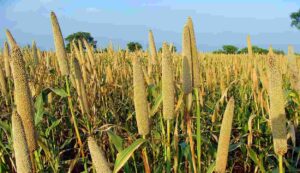Millet Cultivation: Do this work in millet cultivation, you will get double profit
Millet Cultivation: The time to plant millet has also arrived with the start of the Kharif season. In addition to being a staple crop in states like Rajasthan, Haryana, Gujarat, and Uttar Pradesh, millet is also regarded as a crop that produces well at a cheap cost and is resistant to drought. Farmers may quadruple their output and profit if they remember a few key points.

The best time of year to plant millet is said to be between the final week of June and the middle of July. In addition to increasing crop quality, timely seeding lowers losses from pests and illnesses.
Use certified, disease-free, and highly productive seeds wherever possible. Major kinds that produce well even with less water are “Raj-171,” “HHB-67,” “ICTP-8203,” and others.
With proper management of manure and fertilizer, production will rise
The millet crop has unique nutritional needs. Applying 8–10 tons of cow dung manure per hectare during field preparation is advantageous. In addition, each acre needs 60 kilograms of nitrogen, 30 kg of phosphate, and 20 kg of potash.
Half of this amount should be used at the time of sowing, and the other half should be applied as a top dressing 25–30 days later. Grain yield and quality are directly impacted by fertilizer balance.
Attend to watering and weed control
The first irrigation should be done right after planting, and the second irrigation should be done before blooming. Millet is a crop that yields well even with little watering. Additionally, weed management is crucial 15 to 20 days following seeding. If necessary, apply the proper herbicides for this as well as weeding.
Crop management will boost profits
Millet yields may be increased by 25–40% if farmers do their best effort in seed selection, fertilizer management, weed control, and irrigation. In addition to increasing output, this will result in improved market pricing, which might double the profit.

